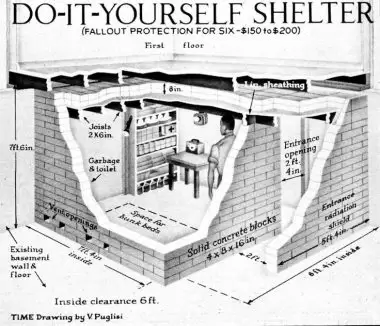Surely you’ve noticed a spike in advertisements for emergency supplies — they’ve enjoyed a booming business thanks to the twin forces of climate change and geopolitical tensions.
 A subset of this product category is the underground shelter for protection from everything from extreme weather to, on the high end, nuclear war. The former might resemble a sub-basement type of structure whereas the latter might include a purified oxygen supply, backup power generators, storage space and incognito placement 10 meters below the ground.
A subset of this product category is the underground shelter for protection from everything from extreme weather to, on the high end, nuclear war. The former might resemble a sub-basement type of structure whereas the latter might include a purified oxygen supply, backup power generators, storage space and incognito placement 10 meters below the ground.
Never fear: You might be able to dig an underground shelter for as little as $10 per square foot — or even free if you are resourceful, according to Survivopedia.
Build or Buy
And if you’re intending to build it on your own property you might be able to get right to it without having to first apply for a permit with your local municipal government — assuming you’re planning something no larger than 200 square feet, which in most locations isn’t subject to building codes.
You should still check with your local government’s specific regulations on new construction before you — or your contractors — start digging.
Speaking of which, the lower you dig, the more types of protection your underground shelter can offer and the more room you might have to build. However, proceeding lower takes your project from something you might be able to do yourself with something you’ll need to hire a contractor to do.
Wait for It
That hiring doesn’t just require money — it requires patience. The average construction company has a nine-month backload of projects — and that’s in locations that are not currently recovering from natural disasters like wildfires or hurricanes. Assume the wait is two years or more in a FEMA recovery zone.
The most cost-effective way to build an underground shelter involves a variation on sandbags: so-called earthbags, made from polypropylene and usually about 18″ by 30″ in size. You fill the earthbags with dirt, stack them like bricks and tamp them together solidly after you place down a full row.
These bags tend to come in lots of 1,000 for anywhere from $220 to $570 per bunch; sellers include Fisher Bag, United Bags, Uline, and Trademark.
Ground Control
Before you dig anything, let alone start fussing with earthbags, you need to figure out what kind of soil conditions you face: you might have to build above ground and then cover the structure with earth afterward if the soil is soft and shifts around.
Building completely underground usually requires construction machinery and reinforcement with masonry in some form.
Only if you’re building above ground or partially underground should you try to build it yourself using earthbags — or any other building material, for that matter.
Join a Community
Another alternative entails applying to join an underground shelter community like Ark Two in Canada or Vivos, which has a couple of locations around the world.
Although at first, these two choices might sound like less work or less spending, don’t presume that’s the case. Both consider applicants’ ability to contribute to a community focused on survival, and if you are accepted, then the topic of money comes up.
The one drawback about either community option: You would have to get to the underground shelters awfully quick in an emergency and if you live far away from their locations, you might not get there in time.
Other Underground Shelters
Of course, the ultimate in risk management — and underground shelters are a form of risk management — might entail applying to the communities and also looking into building some form of underground shelter on your property.
You could further hedge your bets by building a simple structure on your property to tide you over while you wait for your turn for either a back ordered shelter or a custom version built by a construction company.
All of these choices seem far more prudent than not taking any steps to prepare for emergencies. Skipping this appears to have increasingly catastrophic consequences, at least if the past year’s cost of disaster recovery is any indication.
Readers, how worried are you about disasters, both of the natural variety and manmade? And has it motivated you to shop for supplies of any kind?
Jackie Cohen is an award winning financial journalist turned turned financial advisor obsessed with climate change risk, data and business. Jackie holds a B.A. Degree from Macalester College and an M.A. in English from Claremont Graduate University. When she’s not working, you’ll find her geeking on out on insurance and reading about personal finance or the environment.

